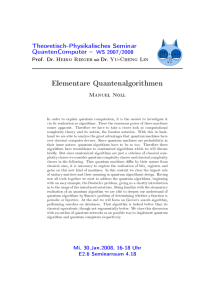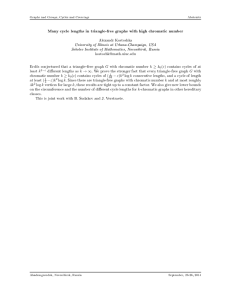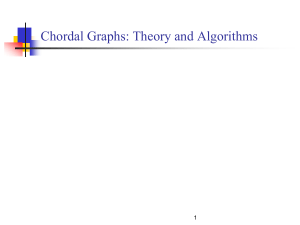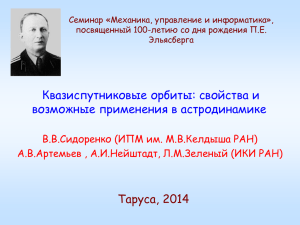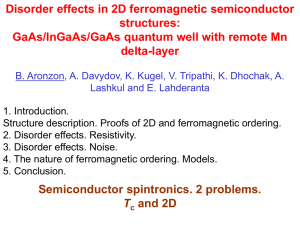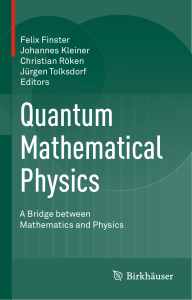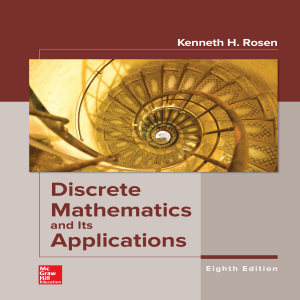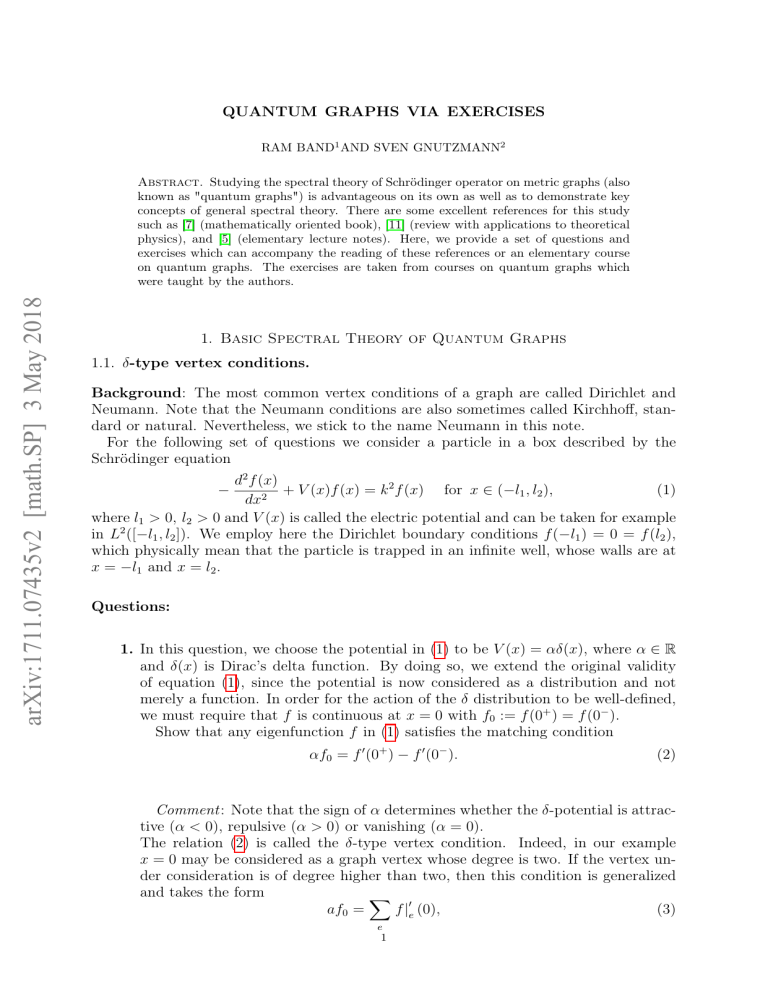
QUANTUM GRAPHS VIA EXERCISES
RAM BAND1 AND SVEN GNUTZMANN2
arXiv:1711.07435v2 [math.SP] 3 May 2018
Abstract. Studying the spectral theory of Schrödinger operator on metric graphs (also
known as "quantum graphs") is advantageous on its own as well as to demonstrate key
concepts of general spectral theory. There are some excellent references for this study
such as [7] (mathematically oriented book), [11] (review with applications to theoretical
physics), and [5] (elementary lecture notes). Here, we provide a set of questions and
exercises which can accompany the reading of these references or an elementary course
on quantum graphs. The exercises are taken from courses on quantum graphs which
were taught by the authors.
1. Basic Spectral Theory of Quantum Graphs
1.1. δ-type vertex conditions.
Background: The most common vertex conditions of a graph are called Dirichlet and
Neumann. Note that the Neumann conditions are also sometimes called Kirchhoff, standard or natural. Nevertheless, we stick to the name Neumann in this note.
For the following set of questions we consider a particle in a box described by the
Schrödinger equation
d2 f (x)
+ V (x)f (x) = k 2 f (x) for x ∈ (−l1 , l2 ),
(1)
dx2
where l1 > 0, l2 > 0 and V (x) is called the electric potential and can be taken for example
in L2 ([−l1 , l2 ]). We employ here the Dirichlet boundary conditions f (−l1 ) = 0 = f (l2 ),
which physically mean that the particle is trapped in an infinite well, whose walls are at
x = −l1 and x = l2 .
−
Questions:
1. In this question, we choose the potential in (1) to be V (x) = αδ(x), where α ∈ R
and δ(x) is Dirac’s delta function. By doing so, we extend the original validity
of equation (1), since the potential is now considered as a distribution and not
merely a function. In order for the action of the δ distribution to be well-defined,
we must require that f is continuous at x = 0 with f0 := f (0+ ) = f (0− ).
Show that any eigenfunction f in (1) satisfies the matching condition
αf0 = f 0 (0+ ) − f 0 (0− ).
(2)
Comment: Note that the sign of α determines whether the δ-potential is attractive (α < 0), repulsive (α > 0) or vanishing (α = 0).
The relation (2) is called the δ-type vertex condition. Indeed, in our example
x = 0 may be considered as a graph vertex whose degree is two. If the vertex under consideration is of degree higher than two, then this condition is generalized
and takes the form
X 0
af0 =
f |e (0),
(3)
e
1
2
R. BAND & S. GNUTZMANN
where the sum is taken over all edges adjacent to the considered vertex, and in
all the summands the derivative is taken to be directed towards the vertex. In
addition, we always require the continuity of the function at the considered vertex,
i.e., all adjacent edges agree in the value they obtain at the vertex, and this value
equals f0 .
Note that the Dirichlet and Neumann conditions are obtained as special cases of
the δ-type vertex condition for some particular values of the parameter (α = 0 for
Neumann and α → ∞ for Dirichlet).
2. Next, we find the spectrum of the problem above: the interval [−l1 , l2 ] with Dirichlet conditions at the end points,
f (−l1 ) = f (l2 ) = 0,
(4)
and a δ-type vertex condition at x = 0,
f (0+ ) = f (0− )
0
+
(5)
0
−
αf0 =f (0 ) − f (0 ).
(6)
(a) Show that the non-negative eigenvalues k 2 of the one-dimensional Laplacian,
d2
− dx
2 , with the vertex conditions (4),(5),(6) are given as the zeros of the
following function
ζα (k) = α + k cot(kl1 ) + k cot(kl2 ).
(7)
We call such a function, whose zeros provide the graph’s eigenvalues, a secular
function.
(b) For an irrational lengths ratio (l1 /l2 ∈
/ Q) show that there cannot be any
eigenfunctions with f0 = 0.
Conclude that the poles of the secular function, (7), cannot belong to the
spectrum.
(c) Show that ζα (k) has only single poles if l1 /l2 ∈
/ Q.
However, if l1 /l2 ∈ Q there are single and double poles of the secular function.
Locate them and show that the double poles belong to the spectrum, while
the single poles do not belong to it. This justifies the need of regularization
of the secular function
ζ̃α (k) = ζα (k) sin(kl1 ) sin(kl2 ).
(8)
Namely, the zeros of the regularized secular function, ζ̃α (k), correspond to
the Laplacian eigenvalues (irrespective to the value of l1 /l2 ).
(d) Consider an attractive δ-potential (α < 0). Are there negative eigenvalues
among the eigenvalues of the Schrödinger operator? Under what conditions
and how many?
(e) Show that if α = 0 in the problem above, this is equivalent to solving the
eigenvalue problem of the Laplacian on the interval, [−l1 , l2 ] with Dirichlet
conditions at the boundaries, but with no additional condition at x = 0.
Conclude that this is the case in general. Namely for any graph, a vertex of
degree two with Neumann vertex conditions (α = 0) is superfluous, i.e. one
QUANTUM GRAPHS VIA EXERCISES
3
can erase the vertex and join the two incident edges to a one single edge such
that the lengths add up.
Hint: You can read about this in [5, section 2.2]
Comment: Equation (7) introduces a secular function which possess poles. The regularization process provides the secular function (8) with no poles. This latter secular
function is the more standard one. There is an explicit formula for it (with no need of
regularization), which makes it also more convenient to use in proofs and analysis on
quantum graphs. See more about that in Section 1.4.
1.2. From the interval to the star graph.
Background: Consider a star graph which consists of one central vertex which is connected to all other V − 1 vertices. We will enumerate the vertices as i = 0, 1, . . . , E where
E = V − 1 is the total number of edges. The central vertex is privileged to have the index
i = 0. The lengths of the edges are {l01 , . . . , l0E }. The restrictions of a function f to the
edges are denoted by {f01 , . . . , f0E }. The coordinates along the edges are chosen according
to the convention that x0i = 0 at the central vertex and x0i = l0i at the vertex i. We will
assume Dirichlet boundary conditions at the vertices i = 1, . . . , E, and a repulsive vertex
potential whose strength is α0 ≥ 0 at the central vertex. Namely, the vertex conditions
at the boundary vertices are δ-type vertex conditions:
∀ 1 ≤ i ≤ E ; f0i (l0i ) = 0,
and the vertex conditions at the central vertex are
∀ 1 ≤ i < j ≤ E ; f0i (0) = f0j (0) ≡ f0
and
E
X
f0i0 (0) = α0 f0 .
i=1
Note that the problem considered in section 1.1 is a special case of the problem considered here with E = 2.
Questions:
3. Show that a possible secular function for the graph is
E
α0 X
ζ(k) =
+
cot(kl0i ).
k
i=1
(9)
Namely, show that zeros of this function are all eigenvalues of the graph (note that
there is not necessarily one to one correspondence - see the next question).
Note that the secular function, (7) in the previous question is a special case of
the one above (with E = 2).
4. What is the weakest assumption you need to assume in order to have a one to
one correspondence between the zeros of the secular function (9) and the graph’s
eigenvalues?
5. Show that under the assumption you got in the previous question, the graph’s
spectrum is non degenerate. Namely, that each eigenvalue appears with multiplicity one.
4
R. BAND & S. GNUTZMANN
6. Under the same assumption as in questions 4 and 5 show the following interlacing
properties:
(a) The Dirichlet spectrum (α0 → ∞) of the star graph interlaces with the spectrum of the same star graph but with a Neumann vertex condition at the
central point (α0 = 0).
(b) For any positive value of α0 the n-the eigenvalue of the star graph is bounded
from below by the n-th eigenvalue for α0 = 0 and from above by the n-th
eigenvalue of the Dirichlet spectrum.
(c) Similarly to the previous question, which interlacing property holds for the
n-th eigenvalue of the star graph with a negative value of α0 ?
Comment: See [7, theorem 3.1.8] for a general statement on eigenvalue interlacing
for quantum graphs.
7. Assume now that α = 0 (Neumann vertex conditions at the center). Consider all star graphs with any number of edges E and anyPpositive edge lengths
{l01 , . . . , l0E }, such that the total length of the edges, L = E
i=1 l0i is fixed.
(a) What is the supremum of the first eigenvalue among all choices of values for
E and {l01 , . . . , l0E } (under the constraint above)? Is this supremum attained
(i.e., is it a maximum)?
(b) What is the infimum? Is it attained?
Hint: The answer can be found in [9].
Comment: Similar questions of eigenvalue optimization on graphs and bounds on
the eigenvalues are discussed in the recent works [1, 2, 6, 14]
8. This is a numerical exercise! Choose any value for the number of edges, E, and
any values for the edge lengths {l01 , . . . , l0E }. Plot the secular function for your
choice and find its thirteen first zeros.
1.3. Secular function - first approach.
Question:
9. Consider an arbitrary quantum graph with V vertices and E edges. Assume there
is an edge connecting vertices 1 and 2 and write the restriction of a function f to
this edge as
f12 (x12 ) = A cos kx12 + B sin kx12 .
Similarly, write
fij (xij ) =
fj sin(kxij ) + fi sin(k(lij − xij ))
,
sin klij
QUANTUM GRAPHS VIA EXERCISES
5
for the restriction of f to an edge connecting vertices i, j (i < j). Using this,
obtain a set of homogeneous equations for the coefficients A, B, fi (i = 1, 2, . . . V )
and derive a secular function that does not have poles at the Dirichlet spectrum
of the edge e = (1, 2).
Hint: There is more than one solution to this - one may also reduce the number of equations (and variables) easily to V (the number of vertices) without
re-introducing poles.
1.4. Secular function - scattering approach.
Background: One may express the restriction of the eigenfunction to the edge connecting
vertices i, j by
−ikxij
ikxij
,
(10)
fij (xij ) = ain
+ aout
ij e
ij e
2
out
where ain
ij and aij are some coefficients. If the eigenfunction belongs to the eigenvalue k ,
we can always choose values to those coefficients, such that expression (10) holds.
For a given vertex i of degree di we have di coefficients of the type ain
ij and another di
out
coefficients of the type aij . Let us collect these into di -dimensional vectors ~a(i),out , ~a(i),in ∈
Cdi . The vertex conditions on the vertex i allow us to express the ~a(i),out as a linear
transform of the ~a(i),in
~a(i),out = σ (i) (k)~a(i),in .
(11)
The components of the vectors ~a(i),out , ~a(i),in ∈ Cdi have the meaning of incoming and
outgoing wave amplitudes; σ (i) (k) is a unitary matrix of size di × di and is called the
vertex scattering matrix.
To each quantum graph with E edges one may associate a unitary matrix U (k) of dimension 2E × 2E, known as the graph’s quantum map or (discrete) quantum evolution
operator that describes the connectivity of the graph, the matching conditions at the
vertices and the eigenvalue spectrum of the graph. In Question 12 the quantum map is
derived explicitly for a particular graph. The same procedure may be applied to other
quantum graphs to find the quantum map.
Questions:
10. Show that the δ-type vertex conditions
P(i.e., 0continuity of the eigenfunction at
a vertex i of degree di and , αi fi =
j∈Vi fij (0)) are equivalent to the vertex
scattering matrix
( 2
j 6= j 0
α
2
di +i ki
(i)
σjj 0 (k) =
− δjj 0 =
.
(12)
2
di + i αki
j = j0
α − 1
di +i i
k
11. Show that the vertex scattering matrix
σ (i) = −1di +
2
Ed
vi + i αki i
is unitary. Here, Edi is the full di ×di matrix with all matrix elements equal to one.
You may use E2di = di Evi and E∗ = E where E∗ denotes the hermitian conjugate
of E.
12. Consider a star graph which consists of three edges. The central vertex is denoted
by 0 and supplied with Neumann vertex conditions. The boundary vertices are
6
R. BAND & S. GNUTZMANN
denoted by 1, 2, 3 and are supplied with Neumann, Dirichlet, Dirichlet conditions,
correspondingly. These notations and the edge lengths are shown in Fig. 1.
N
1
l01
l02
2
0
N
D
l03
3
D
Figure 1. A star graph.
In this question you will explicitly build up the quantum map of the graph above
by following the given sequence of instructions.
(a) Write explicitly the scattering matrices, σ (i) , which correspond to each of the
vertices 0, 1, 2, 3. You may compare with equation (12) above.
(b) Write the equation (11) for each of the vertices. Use the explicit matrices
which you have found in the previous section and write the components of
the vectors ~a(i),in and ~a(i),out with explicit indices in each case (i.e., write
(2),in
(0),out
a0 , a 3
, etc.).
(c) Write (explicitly again) the “big” scattering matrix S(k) to fit the following
set of equations
~a out = S(k)~a in ,
where
out
in
a01
a10
aout
ain
10
01
in
aout
a20
out
in
02
~a = in and ~a = out .
a20
a02
aout
ain
03
30
out
a
ain
30
03
Remember that S(k) merely consists of the different components of the single
vertex scattering matrices σ (i) (k) and zero elements for edges that are not
connected to each other. Pay special care to the order of the entries of the
vectors above.
(d) Write the matrix T (k) such that it fits into the set of equations
~a in = T (k)~a out
with ~a in and ~a out as given above.
Hint: you may use the fact fij (x) = fji (lji − x)
(e) A few tips to check yourself (no need to calculate, just in order to verify your
answer).
i. The matrix S(k) should be k-independent.
ii. The matrix S(k)should be unitary.
QUANTUM GRAPHS VIA EXERCISES
7
iii. The matrix T (k) should be diagonal.
If you did all the above correctly, the quantum evolution operator is obtained by
matrix multiplication of the two matrices, U (k) = T (k)S(k).
13. Consider a star graph with Neumann vertex conditions at the central vertex i = 0
and Dirichlet vertex conditions at the boundary vertices i = 1, 2, . . . , E. Derive the
quantum evolution map U (k) and show that the secular function can be reduced
to the form
ζ(k) = det (12E − U (k)) = det 1E + Te(2k)σ (0) ,
where σ (0) is the central vertex scattering matrix and Te(k) is a diagonal E × E
matrix, T (k)ee0 = δee0 eikle . You can gain a good intuition for the solution of this
question from your solution to the previous question.
14. Show that the following secular function is real
p
ζ̃(k) = det (S ∗ (k)T ∗ (k))det (12E − U (k)) .
(13)
Remember that U (k) = T (k)S(k) and use the unitarity of T (k) and S(k).
Comment: The secular function ζ̃(k) above may even be differentiable in k, if the
complex branch of the square root is appropriately chosen.
2. Trace Formula and Periodic Orbits
2.1. The Trace Formula for the Spectrum of a Unitary Matrix.
Background: Consider an M × M unitary matrix U with unimodular eigenvalues eiθ`
for ` = 1, . . . , M . One may extend the spectrum of eigenphases θ` periodically beyond
the interval 0 ≤ θ < 2π. The extended spectrum then consists of the numbers
θ`,n = θ` + n2π
n∈Z.
Assume that θ` 6= 0 and θ 6= θ`,n is real.
Question:
15. Consider the spectral counting function
N (θ) =
M
∞ X
X
ϑ(θ − θ` − n2π),
n=0 `=1
where ϑ is the Heaviside step function. Show that one may write it as the following
trace formula.
Mθ
1
1
N (θ) =
− Im log det (1 − U ) + Im log det (1 − e−iθ U ).
2π
π
π
Comment: The definition of the spectral counting function may be extended to
θ = θn,` such that both expressions (the defining expression and the trace formula)
remain consistent. For this one replaces the last term in the trace formula by the
limit
1
1
Im log det (1 − e−iθ U ) 7→ lim+ Im log det (1 − e−iθ− U )
→0 π
π
8
R. BAND & S. GNUTZMANN
and sets ϑ(0) = 1/2. Replacing U 7→ e− U and considering the limit → 0+ also
helps to regularize certain expansions that may come up in the proof of the trace
formula because the trace formula for finite > 0 does not have any singularities
for θ on the real line.
We strongly recommend plotting the regularized expression for N (k) with a
(small) positive value for for a given unitary matrix U (which may be chosen
diagonal).
Hint: There are several ways to perform the derivation. One interesting derivation is based on Poisson summation. This method requires -regularization as
mentioned in the comment above.
(a) Write the spectral counting function as
N (θ) =
∞ X
M
X
ϑ(θ − θ` − n2π)ϑ(θ` + n2π).
n=−∞ `=1
(b) The Poisson summation formula for a smooth function f (x) which decays sufficiently fast for |x| → ∞ (so that all sums and integrals converge absolutely)
reads
∞
∞ ˆ ∞
X
X
f (n) =
e2πiνx f (x)dx .
n=−∞
−∞
ν=−∞
PM
We want to apply it to f (x) = `=1 ϑ(θ − θ` − 2πx) ϑ(θ` + 2πx) which is not
smooth. In this case the Poisson sum is not absolutely convergent but may
be regularized by introducing an additional factor e−|ν| and taking the limit
→ 0+ .
(c) While using the formula above, evaluate separately the ν = 0 term from the
other terms.
(d) Compare this term by term to the expansion
log det (1 − e
−iθ
−iθ
U ) = tr log (1 − e
∞
X
1 −inθ−n
U ) = − lim+
e
tr U n
→0
n
n=1
(or the complex conjugate version) in order to perform the sum over ν in the
Poisson summation.
Comment: You may compare this to the trace formula of a quantum graph. Do
this by showing that the above formula is equivalent to the one obtained in [11]
for quantum graphs if all the edge lengths of the graph are the same. Note that
the derivation of the trace formula in this reference uses a different (more general)
method.
2.2. Periodic Orbits.
Background: Consider a quantum graph with E edges of lengths le (e = 1, . . . , E) with
Neumann matching conditions and let U (k) be the unitary, k-dependent 2E × 2E matrix
U (k)α0 α = eiklα0 Sα0 α
where Sα0 α is the scattering amplitude from the directed edge α to directed edge α0 .
QUANTUM GRAPHS VIA EXERCISES
9
Note that Sα0 α = 0 unless the end vertex of the directed edge α coincides with the start
of α0 – one then says that α0 follows α.
We have
n
tr U (k) =
2E
X
eiklα1 Sα1 αn eiklαn Sαn αn−1 . . . eiklα3 Sα3 α2 eiklα2 Sα2 α1 ,
α1 ,...,αn =1
where {α1 , . . . , αn } is a set of n directed edges of the graph. In the sum above, each term
is of the form Aγ eik`γ
Aγ = Sα1 αn Sαn αn−1 . . . Sα2 α1
`γ = lαn + lαn−1 + . . . l1
Here γ = (α1 , . . . , αn ) is a fixed set of summation indices which corresponds to a sequence
of directed edges.
Note that Aγ 6= 0 only if the edge αj+1 follows the edge αj in the graph, for j = 1, . . . , n
(in this context αn+1 ≡ α1 ) – i.e. only if γ is a closed trajectory on the graph. For such a
trajectory, lγ is its total length, i.e., the sum of its edge lengths. By definition, the length
spectrum of the graph is the set of all lengths {lγ } of closed trajectories. You can see a
few examples of such closed trajectories in Fig. 2.
Figure 2. Three examples of closed trajectories on a graph.
We now list a few observations and definitions related to periodic orbits.
• Note that any cyclic permutation, γ 0 , of the indices in the trajectory γ gives a
different closed trajectory with the same contribution Aγ 0 = Aγ and `γ 0 = `γ .
• The equivalence class γ = α1 . . . αn that contains all cyclic permutations of a given
closed trajectory γ = (α1 , . . . , αn ) is called a periodic orbit with period n on
the graph.
• The periodic orbit γ = α1 . . . αn is a primitive periodic orbit of primitive period n if the sequence of indices α1 , . . . , αn is not a repetition of a shorter sequence.
All the closed trajectories in Fig. 2 represent primitive periodic orbits.
• If γ is a periodic orbit with period n, then there exists a unique primitive periodic
orbit γ p with primitive period np such that γ is a repetition of γ p and n = rnp .
Here r ≥ 1 is the integer repetition number of γ and np the primitive period
of γ.
• If r = 1 then γ = γ p and γ is primitive.
• We write γ = γ pr for the r-th repetition of the primitive orbit γ p .
10
R. BAND & S. GNUTZMANN
Comment: The trace formula of the spectral counting function may be expressed in
terms of an infinite sum over the graph’s periodic orbits. To answer the following questions, you should read more about that, for example in [7, section 3.7.4] or [11, section 5.2].
Questions:
16. Consider the dihedral graphs as given in Fig. 3
Figure 3. Two isospectral quantum graphs. Their edge lengths are indicated by the parameters a, b, c. The vertices marked with ‘D’ have Dirichlet
conditions and all other vertices have Neumann conditions.
It is known that those graphs are isospectral [3]. Solve the following ‘paradox’:
The isospectrality of those graphs means that their spectral counting functions
are equal. Hence, the periodic orbit expansions of those counting functions are
the same. Therefore, both graphs should have the same set of periodic orbits.
Nevertheless, the graph on the left has a periodic orbit of length 2a, whereas the
graph on the right does not have such an orbit. How is this possible?
17. This question concerns the tetrahedron graph, i.e. the complete Neumann graph
with V = 4 vertices.
(a) Warm-up: Choose two periodic orbits on the graph, such that one of them
is primitive and the second is some repetition of the first. For each of those
periodic orbits, γ, evaluate the following quantities:
(i) The period n of the orbit.
(ii) The length `γ of the orbit (expressed in terms of the graph edge lengths).
(iii) The coefficient Aγ which corresponds to the orbit in the periodic orbits
expansion (write the explicit number).
(iv) The primitive period np and the repetition number r ?
(b) Assume that all bond lengths are incommensurate. Go over all periodic orbits of period n = 5 and write their contribution to the length spectrum σ`
(expressed in terms of the graph edge lengths). What are the corresponding
quantum amplitudes Aγ of those orbits?
(c) Now assume that all edge lengths are equal. How does your answer to the
previous question change?
QUANTUM GRAPHS VIA EXERCISES
11
(d) The connectivity matrix C of a simple graph with V vertices is the real
symmetric V × V matrix with entries
(
1 vertices i and j are connected by an edge,
Ci,j =
0 else.
Note that for simple graphs there are no loops, i.e. edges that connect a
vertex to itself, so ∀i, Cii = 0. The connectivity matrix may be used to count
the number of trajectories that connect the vertices i and j in n steps – this
number is just [C n ]ji .
Consider the connectivity matrix of the tetrahedron, Cij = 1 − δij .
Show that as n → ∞, [C n ]ji ∼ ceαn and find α.
Hint: diagonalize C.
Comment: The last question shows that there is an exponential growth in the
number of orbits on the graph. This holds in particular for periodic orbits and
makes it difficult to use the periodic orbit expansion of the trace formula for spectral computations.
18. In the previous question we counted the number of trajectories between two vertices via the (vertex) connectivity matrix. An alternative approach is based on
the 2E × 2E edge adjacency matrix B whose indices correspond to the directed
edges where
(
1 if α follows α0 ,
Bαα0 . =
0 else.
The main difference is that [B n ]αα0 counts the number of trajectories that start on
the directed edge α0 and end after n steps on the directed edge α. Both approaches
can also be used to count the number of periodic orbits via the traces. We will
explore this here for the edge connectivity matrix B.
P
(a) Show that n1 tr B n = γ:nγ =n r1γ where the sum is over all periodic orbits of
period n. Conclude that if n is a prime number then n1 tr B n is the number of
periodic orbits of period n.
(b) Derive an expression for the number of periodic orbits of period n in terms of
traces of powers of B for
(i.) n = pj where p is a prime number and j ≥ 2 an integer, and
(ii.) n = p1 p2 where p1 and p2 are prime numbers.
Make an educated guess forQthe general expression when n has the prime
number decomposition n = m pjmm where jm ≥ 0 is the multiplicity of the
m-th prime.
19. This question demonstrates that given some lengths of periodic orbits of an unknown graph, one can reconstruct the graph.
(a) Find the graph with the following properties:
(i.) the total length (sum of all edge lengths) is 1 56 ;
(ii.) the lengths of all periodic orbits whose length is not greater than 5 are
12
R. BAND & S. GNUTZMANN
given by the list
2 1
2
1 2
1 2
, 1 , 2, 2 , 3, 3 , 3 , 4, 4 , 4 , 5.
3 3
3
3 3
3 3
Draw the graph and indicate the edge lengths on the drawing.
(b) Find the graph with the following properties:
;
(i.) the total length is 5 13
15
(ii.) the lengths of all periodic orbits whose length is not greater than 5 are
given by the list
1 1 2
1 1 1 2 1 17 2 11 4
2, 2 , 2 , 2 , 4, 4 , 4 , 4 , 4 , 4 , 4 , 4 , 4 , 4 , 5.
3 6 5
6 3 3 5 2 30 3 15 5
Note that there are two different periodic orbits of length 4 13 . Also, any number which appears only once in the list above indicates that there is exactly
one periodic orbit of that length.
What is the graph this time?
(c) Try to think how to construct a general algorithm for finding the graph out
of knowing its total metric length and lengths of all of its periodic orbits.
Assume that the graph is simple (no loops and no multiple edges) and that
its edge lengths are incommensurate.
Hint: What is the shortest periodic orbit of a graph?
Another hint: The answer can be found in [12].
2.3. The constant term of the Trace formula.
Background: The spectral counting function of a quantum graph is
N (k) := λ ∈ R is an eigenvalue : λ < k 2 ,
where eigenvalues are counted with their multiplicity. One of the forms of the trace
formula for the spectral counting function is
L
1
N (k) = N0 + k − lim Im log ζ̃(k + i),
(14)
→0 π
π
where ζ̃(k) is the real secular function given in (13), and N0 is a constant term. The last
two terms in (14) equal to the number of real zeros of ζ̃ with absolute value smaller than
k. Those zeros are in one to one correspondence with the graph eigenvalues (including
multiplicity), with the exception of k = 0. The value of ζ̃ at k = 0 does not correspond to
the multiplicity of the zero eigenvalue and this ‘mismatch’ is compensated by the constant
term N0 in (14).
The expression for this term was originally derived in [16, lemma 1],[17]. Other works
related to this subject are [10, 13]. Further reading in [7, section 3.7] and [11, section 5]
is recommended.
Question:
20. In the following question we derive the value of N0 for a Neumann graph (all vertex matching conditions are of Neumann aka Kirchhoff type). Initially, assume
~ be the space of directed
that the graph has a single connected component. Let E
QUANTUM GRAPHS VIA EXERCISES
13
edges on the graph (this space is of dimension 2E, where E is the number of edges).
~ → C such that
(a) Let ω : E
~
∀ (i, j) ∈ E
ω (i, j) = −ω (j, i)
and
X
∀i
ω (i, j) = 0,
j∼i
where j ∼ i means that the vertex j is adjacent to the vertex i. All such
~ → C form a vector space (over C). Prove that the dimension
functions ω : E
of this space is β := E − V + 1.
Hint: Start by considering a tree graph.
(i),in
(b) Let ~ain ∈ C2E with entries denoted by aj
is satisfied
∀i ∼ j , i ∼ k
(i),in
aj
(j),in
+ ai
(for i ∼ j), such that the following
(i),in
= ak
(k),in
+ ai
and
∀i
X
(i),in
−aj
(j),in
+ ai
= 0.
j∼i
Prove that the dimension of the vector space which contains all such solutions
~ain ∈ C2E is β + 1.
(c) Note that you have shown dim ker (1 − S) = β + 1, which implies N0 = 1−β
.
2
Show that for a Neumann graph with C (disjoint) connected components, the
constant term of the trace formula (14) is N0 = C−β
.
2
You can use the generalized definition of β, which is β := E − V + C (this
value can be obtained by summing over all the β’s of the different components).
3. Further Topics
3.1. Quantum to Classical correspondence for Quantum Graphs.
Background: In this question we study the classical dynamics of a quantum graph.
This will help us to understand in what sense the classical dynamics that corresponds to
a quantum graph is ’chaotic’. Remember that the quantum evolution map, U (k), contains
amplitudes for scattering processes to go from one directed edge to another. We define a
corresponding classical map, M , by replacing the amplitudes U (k)αα0 by
Mαα0 = |U (k)αα0 |2 = |Sαα0 |2 .
Hence, M is a matrix of dimensions 2E × 2E, which contains the probabilities for the
scattering events.
Question:
21. By following the steps below prove that the matrix M defines a Markov process
on the set of directed edges with the stated additional properties.
14
R. BAND & S. GNUTZMANN
(a) Prove that the matrix M is a bi-stochastic (doubly stochastic) matrix . Namely,
prove that
2B
2B
X
X
0
Mαα =
Mαα0 = 1.
α0 =1
α=1
(b) Use the bi-stochastic property to verify that the following definition of a
Markov process on the directed edges of the graph is well-defined. Let Pα (n)
be the probability to find a particle on the directed edge α, at some (discrete)
time n. We can then define the probabilities to find the particle on the
directed edge α, at time n + 1, by
X
Pα (n + 1) =
Mαα0 Pα0 (n)
α0
or,
P in short P (n + 1) = M P (n). In particular show that if P (n) satisfies
α Pα (n) = 1 and P (n)α ≥ 0, then P (n + 1) satisfies the same properties.
That is if P (n) is a probability vector then P (n + 1) is a probability vector.
Further background: We next consider the equilibration properties of the Markov
1
process P (n + 1) = M P (n). Let P inv = 2E
be the equi-distributed probability vector on
the graph. For any quantum graph this is an invariant probability vector, i.e.
M P inv = P inv
The classical dynamics which corresponds to a quantum graph is chaotic in the following
sense: The Markov process on the graph is called ergodic if
n
1X
lim
P (m) = P inv
n→∞ n
m=1
for every initial probability vector P (0). We call a graph dynamically connected1, if for
any two directed edges α and α0 there is an integer n > 0 such that (M n )αα0 6= 0 (i.e
one can get from one directed edge to another with a non-vanishing probability in a finite
number of steps). Every dynamically connected graph is ergodic. Most graphs are also
mixing which is the stronger property
lim P (n) = P inv
n→∞
for every initial probability vector P (0).
Question:
22. In this question we will characterize ergodicity and mixing in terms of the eigenvalue spectrum of the bi-stochastic matrix M . The results apply to any bistochastic Markov process on a directed graph whether or not there is a corresponding quantum graph such that Mαα0 = |U (k)αα0 |2 in terms of the quantum
map.
(a) Prove that all the eigenvalues of M are either on the unit circle or inside it.
Namely, if we denote the set of eigenvalues by {λi }, then ∀i ; |λi | ≤ 1.
1In
the literature a matrix M with this property is sometimes called irreducible.
QUANTUM GRAPHS VIA EXERCISES
15
(b) We know that M has at least one eigenvalue which equals 1 (the corresponding
eigenvector is P inv ). Let us denote this eigenvalue by λ1 (λ1 = 1). Prove that
if min2≤i≤2E (1 − |λi |) > 0 then the graph is mixing.
Hint: It might be useful to prove the convergence property using the vectors
L1 -norm.
(c) Using the notation above (λ1 = 1), prove that if min2≤i≤2E (|1 − λi |) > 0 then
the graph is ergodic.
Hint: Again, use the L1 -norm .
Comment: Note that the conditions above are consistent with the trivial fact
that mixing is a stronger notion than ergodicity (namely, that every mixing system
is also ergodic which follows directly from the definition).
The quantity ∆ := min2≤i≤2E (|1 −Pλi |) is called the spectral gap and it determines
the convergence rate of limn→∞ n1 nm=1 P (m) (the greater the gap, the quicker is
the convergence).
˜ := min2≤i≤2E (1 − |λi |) determines the convergence rate of limn→∞ P (n).
Similarly, ∆
3.2. The quadratic form.
Background: Consider a quantum graph with the edge and vertex sets, E and V. We take
the operator to be the Laplacian with δ-type vertex conditions (see (3)). The quadratic
form of this operator is:
X ˆ le df dg
X
h[f ] :=
αv f (v)g(v),
dxe +
dxe dxe
e∈E 0
v∈V ; α 6=∞
v
where αv is the coupling coefficient of the δ-type vertex condition at vertex v, and αv = ∞
indicates Dirichlet vertex conditions. The length of the edge e is denoted by le .
The domain D(h) of this quadratic form consists of all functions f on the metric graph
that satisfy the following three conditions:
(i.) for each edge e the restriction f |e belongs to the Sobolov space H 1 ([0, le ]),
(ii.) f is continuous at each vertex, and
(iii.) f (v) = 0 at each vertex v for which αv = ∞.
The quadratic form is useful for variational characterization of the spectrum. More on
this topic is found in [7, section 1.4.3].
Questions:
23. Consider a Schrödinger operator with a bounded non-negative potential (V ≥ 0)
on a quantum graph, Hψ = −ψ 00 +V ψ. Show that the spectrum of this operator is
non-negative if all the vertex conditions are of δ-type with non-negative coupling
coefficients (i.e., ∀ v ∈ V ; αv ≥ 0).
Hint: You need to modify the quadratic form given above to fit the case of
Schrödinger operator with a potential.
24. Prove the following statements:
(a) Let λ = λ(α) be a simple eigenvalue of a graph with δ-type vertex condition
at a certain vertex v with the coupling coefficient α 6= ∞. The operator on
16
R. BAND & S. GNUTZMANN
this graph is just the Laplacian (no potential). Then
dλ
= |f (v)|2 .
dα
(b) Now, re-parameterize the δ-type vertex condition at v as:
X df
ζ
(v) = −f (v),
dxe
e∈E
v
with Ev denoting the set of edges adjacent to v. This parametrization allows
Dirichlet condition (ζ = 0) and excludes Neumann condition (ζ = ∞). Show
that if the simple eigenvalue is now given by λ = λ(ζ) then the derivative is
2
X df
dλ
=
(v) .
dζ
dxe
e∈E
v
Hint: The answer is given in [7, proposition 3.1.6]
3.3. From quantum graphs to discrete graphs.
Question:
25. In this question we consider the spectral connection between quantum graphs and
discrete graphs.
(a) Consider an arbitrary quantum graph with V vertices and E edges. Assume
that Neumann conditions are imposed at all vertices and that all edges are
of the same length, l. Use the following representation for an eigenfunction
with eigenvalue k 2 on the edge (i, j)
fij (xij ) =
fj sin(kxij ) + fi sin(k(l − xij ))
.
sin(kl)
and the Neumann conditions to obtain a set of V homogeneous equations for
the variables fi (i = 1, 2, . . . V ).
(b) Denote by f~ the vector whose entries are all the fi variables. Assume that
sin(kl) 6= 0 and manipulate the linear set of equations you got in the previous
section to have the following form
A f~ = cos(kl)f~.
What is the matrix A? Note that this matrix describes the underlying discrete graph and this establishes a spectral connection between the discrete
and the quantum graph.
(c) Denote by {λi }Vi=1 the eigenvalues of A. Express the k-eigenvalues of the
quantum graph (remember that there are infinitely many of those) in terms
of the eigenvalues of A. Are all the eigenvalues of the quantum graph can be
obtained in this way? If so, prove it, or otherwise, point on the eigenvalues
which are not obtained in this way.
QUANTUM GRAPHS VIA EXERCISES
17
Comment: Further reading on the spectral connection between discrete and
quantum graphs may be found in [4, 8, 13, 15, 19]. The most general derivation of
this connection, treating electric and magnetic potentials as well as δ-type vertex
conditions appears in [18].
acknowledgments
We thank the referee whose critical remarks and constructive suggestions has lead to a
profound improvement of the manuscript. RB was supported by ISF (Grant No. 494/14)
and Marie Curie Actions (Grant No. PCIG13-GA-2013-618468).
References
[1] S. Ariturk. Eigenvalue estimates on quantum graphs. preprint arXiv:1609.07471, 2016.
[2] R. Band and G. Lévy. Quantum graphs which optimize the spectral gap. Ann. Henri Poincaré,
18(10):3269–3323, 2017.
[3] R. Band, T. Shapira, and U. Smilansky. Nodal domains on isospectral quantum graphs: the resolution
of isospectrality? J. Phys. A, 39(45):13999–14014, 2006.
[4] J. v. Below. A characteristic equation associated to an eigenvalue problem on c2 -networks. Linear
Algebra Appl., 71:309–325, 1985.
[5] G. Berkolaiko. An elementary introduction to quantum graphs. ArXiv e-prints, Mar. 2016.
[6] G. Berkolaiko, J. B. Kennedy, P. Kurasov, and D. Mugnolo. Edge connectivity and the spectral gap
of combinatorial and quantum graphs. J. Phys. A, 50(36):365201, 29, 2017.
[7] G. Berkolaiko and P. Kuchment. Introduction to Quantum Graphs, volume 186 of Mathematical
Surveys and Monographs. AMS, 2013.
[8] C. Cattaneo. The spectrum of the continuous Laplacian on a graph. Monatsh. Math., 124(3):215–235,
1997.
[9] L. Friedlander. Extremal properties of eigenvalues for a metric graph. Ann. Inst. Fourier (Grenoble),
55(1):199–211, 2005.
[10] S. A. Fulling, P. Kuchment, and J. H. Wilson. Index theorems for quantum graphs. J. Phys. A,
40(47):14165–14180, 2007.
[11] S. Gnutzmann and U. Smilansky. Quantum graphs: Applications to quantum chaos and universal
spectral statistics. Adv. Phys., 55(5–6):527–625, 2006.
[12] B. Gutkin and U. Smilansky. Can one hear the shape of a graph? J. Phys. A, 34(31):6061–6068,
2001.
[13] J. Harrison and T. Weyand. Relating zeta functions of discrete and quantum graphs. Lett. Math.
Phys., 108(2):377–390, 2018.
[14] J. B. Kennedy, P. Kurasov, G. Malenová, and D. Mugnolo. On the spectral gap of a quantum graph.
Annales Henri Poincaré, pages 1–35, 2016.
[15] P. Kuchment. Quantum graphs. I. Some basic structures. Waves Random Media, 14(1):S107–S128,
2004. Special section on quantum graphs.
[16] P. Kurasov and M. Nowaczyk. Inverse spectral problem for quantum graphs. J. Phys. A, 38(22):4901–
4915, 2005.
[17] P. Kurasov and M. Nowaczyk. Corrigendum: “Inverse spectral problem for quantum graphs” [J.
Phys. A 38 (2005), no. 22, 4901–4915; mr2148632]. J. Phys. A, 39(4):993, 2006.
[18] K. Pankrashkin. Spectra of Schrödinger operators on equilateral quantum graphs. Lett. Math. Phys.,
77(2):139–154, 2006.
[19] J. von Below and D. Mugnolo. The spectrum of the Hilbert space valued second derivative with
general self-adjoint boundary conditions. Linear Algebra Appl., 439(7):1792–1814, 2013.
1
Department of Mathematics, Technion–Israel Institute of Technology, Haifa
32000, Israel
2
School of Mathematical Sciences, University of Nottingham, Nottingham NG7 2RD,
UK
